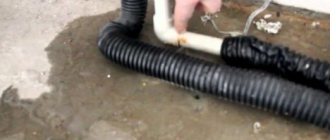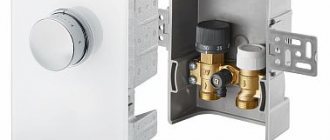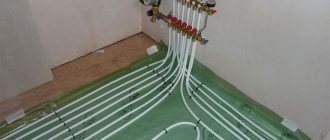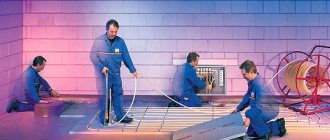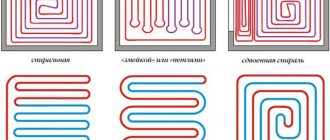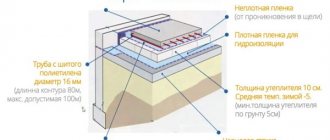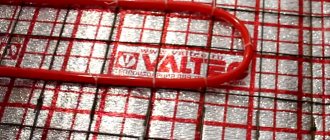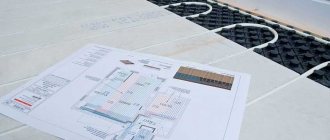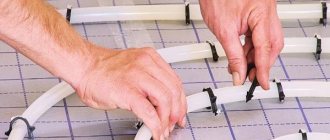Repair and decoration
04/18/2018 Anastasia Prozheva
Heated floors are gaining enormous popularity among the population. In private housing constructions with central gas supply, floor heating from hot water pipes is especially common.
The gas boiler supplies the coolant liquid to a piping system built into the floor structure. Pipes for such systems are made from several types of materials. Among them, cross-linked polyethylene for heated floors attracts attention. What is attractive about a warm floor made of cross-linked polyethylene? This will be discussed in this article.
Types of pipelines for warm water floors
Copper pipes have the best thermal conductivity
Assembling equipment for warm water floors is a rather complex job that requires the involvement of qualified labor. Heating circuits are mounted from pipes made of various materials:
- cross-linked polyethylene pipes;
- metal-plastic pipelines;
- polypropylene systems;
- copper pipes.
Each heating system has its own advantages and disadvantages. Let's compare cross-linked polymer with other pipe materials in the table:
| № | Name of material | Advantages | Flaws |
| 1 | Cross-linked polymer | Strong and durable material | Pipes are susceptible to damage from ultraviolet radiation |
| 2 | Metal-plastic | High flexibility | High price |
| 3 | Polypropylene | Low price | Pipes are bent under heat |
| 4 | Copper pipe | Versatility, high thermal conductivity | The most expensive pipes |
List of works for installing a heated water floor:
- calling a technician to the site;
- project preparation, budget calculation;
- recommendations for the purchase of material (as agreed by the parties);
- surface preparation for finishing coating (thermal insulation, damper tape, reinforcing mesh);
- laying out the pipe on a mesh with fastening it with clamps or on special mats, installing insulation and expansion joints;
- Installation of distribution cabinet with manifold assembly;
- Connecting the floor to the heating boiler;
- Assembly, connection and configuration of automatic floor control (electrical part);
- Pressure testing of the system.
Heated, water-heated floors are combined with various finishing coatings, but the most wear-resistant is the under-tile . It is durable, the temperature difference between the warm floor and the cool stove is quite comfortable for the feet.
Laminate flooring is sensitive to temperature changes, so you should choose a high-quality one. The cost ranges from 1850 - 2000 rubles per 1 square meter.
What is cross-linked polyethylene
The shape of the pipes when bending is maintained thanks to a layer of foil
For an inexperienced reader, the phrase “cross-linked polyethylene” evokes an association with sewing with a needle and thread. This actually means treating the structure of polyethylene at the molecular level.
The polymer is bombarded with electrons under high pressure. The released molecules form links that stitch through the entire polyethylene structure.
Related article: Linen curtains: recommendations for selection and operation
XLPE pipes
Thanks to polyethylene, pipes can withstand high temperature loads
For heating devices made of cross-linked polymer for heated floors, pipes made of three-layer material are used:
- the outer surface consists of a monolithic polymer that serves as a frame;
- the middle layer is an aluminum foil pad; foil does not allow oxygen to pass through and retains the shape of the pipe when it is bent;
- the most important inner layer consists of cross-linked polyethylene for underfloor heating; It is thanks to him that the pipes can withstand heating temperatures of more than 100 degrees and internal pressures of up to 10 bar.
How to bend polypropylene pipes to avoid deformation
During the bending process, polypropylene is acted upon by several physical forces at once. First of all, this is a mechanical force, which gives the necessary bend to the pipe. In this case, the material is slightly compressed along the internal axis, and stretched along the external axis. Such elastic deformation can easily damage the pipe if the procedure is performed incorrectly.
In addition, in most cases the hot bending method is used. At the same time, another factor affects polypropylene - temperature. Like any type of plastic, PPR is not always able to withstand significant temperature effects. Avoiding deformation of the pipe when bending it is possible only by observing safety precautions.
It is worth listening to the advice of experts regarding:
- Exposure temperatures. It should be remembered that polypropylene melts at a temperature of about 140 ͒ C. At the same time, it becomes flexible and the pipe can be bent. However, if you significantly exceed this figure, the pipe may simply melt or break. To prevent this from happening, the exposure temperature should be no more than 150 ͒ C.
- Duration of exposure. The pipe must be heated until it becomes pliable; it is important not to miss the moment when it becomes flexible. Further exposure will contribute to a change in the properties of the material.
- Uniform heating. Regardless of the heating method, it is necessary to ensure that all sides are heated evenly.
- Bending radius. This rule, unlike the previous ones, applies to any method of bending: both hot and cold. It is easy to calculate this parameter; it is worth remembering that the bending radius should exceed the radius of the pipe no more than 8 times. For example, if the radius of the pipe is 5 cm, then the bend should have a radius that does not exceed 40 cm.
We recommend that you read: How to prevent clogging of storm drains - routine cleaning and prevention
The procedure is quite complicated to perform. You may not get the desired result the first time. In addition, when connecting a bent pipe to a heating system, there is always a danger that it will leak at the bend. To avoid this, it is important to choose the correct bending method.
Advantages and disadvantages of cross-linked polyethylene pipes
Environmentally friendly material is not hazardous to health
Let's look at the advantages and disadvantages of cross-linked polyethylene pipes for underfloor heating:
Advantages
- High temperature resistance. The polymer can withstand heating up to 100 degrees or more, maintaining its properties.
- The polymer has reverse shrinkage quality. Pipes made of cross-linked polymer quickly restore their shape after being subjected to deformation loads.
- Due to its elasticity, the pipe for heated floors can be bent at any angle, maintaining its integrity.
- The material is completely environmentally friendly. Even with strong heating, the polymer is not capable of harming the environment.
- Manufacturers provide a guarantee for the impeccable service of cross-linked polyethylene pipes for more than 20 years.
UV radiation is detrimental to such pipes
Flaws
- The polymer “does not tolerate” ultraviolet radiation, so the pipes are stored in complete darkness.
- Pipes are connected using complex fitting structures. The use of special devices greatly facilitates the installation of heated floors made of cross-linked polyethylene.
- The outer surface of the pipelines is “very delicate” and is “afraid” of even light mechanical influences.
Based on many years of testing, it was concluded that the optimal size of the passage hole for a cross-linked polyethylene pipe is 16 mm.
Bending methods and tools
Bending metal-plastic is a responsible process. Too much force applied to the pipe product can deform it or even damage the inner aluminum ball, causing the pipeline to lose its heat-resistant properties.
You can bend a pipe correctly at home using one of the following methods:
- Gently bend by hand.
- Use a specially purchased pipe bender at home.
- Apply the spring.
Purchasing a pipe bender is economically feasible only if there is a significant amount of work. For one-time bending of metal-plastic lines at home, you can use alternative methods.
Bending with a spring
As an aid when bending tubes at home, heating with a construction hairdryer or adding sand is widely used, which gives additional flexibility to the material.
Assembly of heated floors from cross-linked polyethylene
A closed ring of pipelines for underfloor heating is called a circuit. The length of one ring should not exceed 120 m.
Related article: 10 new ideas on how to decorate a children's room (50 photos)
The optimal length of the circuit was determined based on thermal engineering calculations.
If this length is exceeded, the circuit will not be able to provide sufficient floor heating.
To heat large areas, heated floors are made from several circuits.
If you have experience in installing plumbing equipment, it is quite possible to install water-heated floors from cross-linked polyethylene with your own hands. For more information about installation, watch this video:
The installation of heated floors made of cross-linked polyethylene consists of several stages:
- Installing a gas boiler. The unit is connected to the central gas pipeline and to the water supply.
- A collector distribution unit is installed.
- A vapor barrier made of polyethylene film is laid on the finished floor base. The film is placed on the walls around the perimeter of the room at a level greater than the height of the future floor.
The hose is laid on a reinforcing mesh
- Insulation boards (polyurethane, polystyrene foam or other similar material) are placed on the vapor barrier.
- Lay a reinforced mesh of metal or plastic wire.
- Lay out a cross-linked polyethylene hose. Attach it to the mesh with plastic clamps.
- The circuit is made from a single piece of pipe.
- Fittings are installed at the ends of the pipe and connected.
- Install a temperature sensor and connect it to a temperature control device.
- Conducting pipeline tests. Water is supplied at a pressure 1.5 times higher than the standard value.
- If leaks appear, they are eliminated. Then the tests are resumed.
- After this, a concrete screed is installed or the space is filled with a dry backfill of expanded clay chips.
Rating of pipes for heated floors
It is difficult to say which pipe for a water floor is better. Currently, the following types are especially popular:
- Copper
has superior properties to other types, but it is more advisable to use it in a small room due to its high cost. - Polymer pipes
for heated floors are used mainly due to their low cost and practical convenience. It has high heat transfer due to the aluminum layer and immunity to destruction, but they have a large bending radius, which affects the level of heating of the concrete screed. - Stainless steel corrugation
is popular due to its unlimited service life and ease of bending, but when water moves through it, a noise background is created, in addition, corrugated stainless steel is not cheap.
Today, the best manufacturers of pipes for heated floors are:
- Rehau;
- Aquatherma;
- Sanext;
- Upon arrival.
Calculation of pipes for heated floors
To calculate the amount of material, you need to draw up a diagram of the entire system in advance, based on the maximum length of the circuit not exceeding 120 m. Knowing the area of the room, you can determine how to calculate the pipe for a heated floor. On average, 5 linear meters of products are required per 1 m². The step length should be 20 cm. The quantity can be determined using a simple formula: L = S/Nx1.1, where:
- S – area of the room;
- N – laying step;
- 1.1 – pipe reserve for turns.
Filling the floor space with an installed heating system made of cross-linked polyethylene
Filling the base of a heated floor is done in two ways:
- concrete screed;
- dry floors.
Concrete screed
A 50mm tie is enough
The minimum thickness of the screed should be 50 mm. A minimum height of concrete above the pipes of 30 mm will ensure the maximum degree of floor heating.
In order for the floor to heat up quickly and cool down effectively, the thickness of the screed should not exceed 70 mm.
It is necessary to take into account the fact that an excessive thickness of the screed can cause a threatening load on the floor structure.
1 m 2 screeds with a coating thickness of 50 mm weighs 125 kg.
Installation of cross-linked polyethylene pipes
Another important detail in the installation of warm water floors is that before installing the screed along the perimeter of the room, damper tape is glued to the walls. A strip with a thickness of 6 to 30 mm ensures dense filling of the gap between the walls and the screed.
The size of the adhesive tape must exceed the height of the screed layer. The damper layer compensates for the increase in the area of heated concrete. For more information about floor construction, watch this video:
If the floor area exceeds 30 m2, then the concrete base is divided into several sections, delimited by expansion joints 10 mm wide.
Dry floors
A device for dry filling of heated floors made of cross-linked polyethylene in the event of an emergency pipeline leak will allow you to avoid labor-intensive work on dismantling the floor.
Expanded clay sand can be easily removed. After repairing the pipes, the dried expanded clay chips are returned to their place, so it is best to make your heated floor from dry backfill.
If you do not have experience in installing heated water floors yourself, it is recommended to leave this work to specialists.
The best posts
- How to make a house from plasticine for dolls with your own hands with photos and videos
- Felt boots: DIY crafts with patterns made from wool and paper
- Electric mop for washing floors: reviews and tips for choosing
- How to save money on tiles: designer tips
- Knitted items in apartment interior decor
- Interior of a small bedroom 9 sq m with your own hands: design rules (photo)
- Piping in the bathroom - tips from the experts
- 50 DIY gift ideas for March 8 (36 photos)
